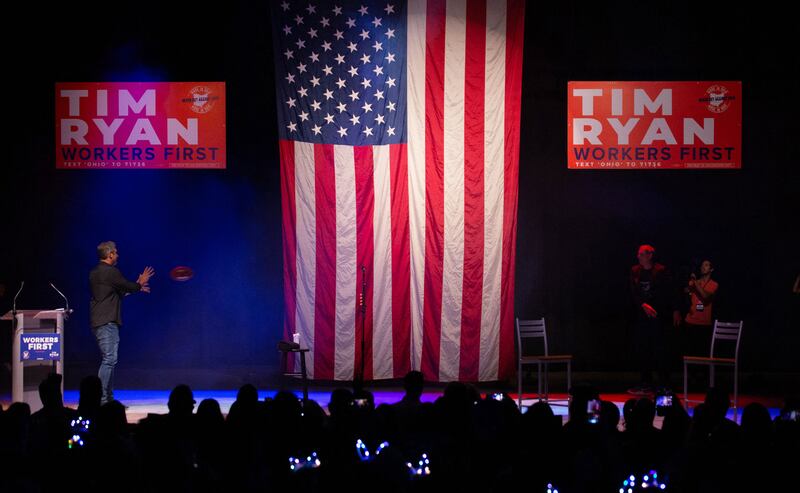Democrats are playing catch-up as Rep. Tim Ryan makes it a close race for the open U.S. Senate seat from Ohio—with little help from his party.
Republicans have put some $40 million into ads for Hillbilly Elegy author J.D. Vance’s campaign since Labor Day, versus $4.5 million from Dems for Ryan. But Ryan has turned a race that Vance should easily win (given Ohio’s red tilt and an unpopular Democrat in the White House) into a cage match.
Both are native Ohioans, with Vance shaped by the struggles of Appalachia, and Ryan by a depressed steel town. But Vance left to make his fortune in Silicon Valley, and Ryan doesn’t want voters to forget it.
Ryan’s blueprint for victory is winning back the white working-class vote, a segment of the population that strategists once thought would be overtaken by demographic change that favors Democrats. Instead, blue collar, non-college educated white men—some who voted for Obama and then Trump—remain a critical vote, and a bulwark against rising right-wing populism. Ryan is putting down a marker that Democrats should heed, even if it’s not enough to carry him to victory this time around.

Supporters before a campaign event for US congressman Tim Ryan, Democrat Senate candidate for Ohio, in Columbus, Ohio, on Oct. 24, 2022.
Megan Jelinger/AFP via Getty ImagesBill Galston, a senior fellow in the governance program at the Brookings Institution, says he thinks it’s a shame Ryan’s party hasn’t made a greater investment in the Ohio Senate race, “because Tim Ryan is showing Democrats how to address their most serious electoral weakness, on terrain that has become unfamiliar to Democrats.”
Noting that Ohio, once “the quintessential swing state,” is now deeply red, Galston says the combination of Democratic Sen. Sherrod Brown, who was reelected in 2018, and Tim Ryan in the U.S. Senate “would send a powerful message to the senate and the country” about the politics and priorities of the Democratic Party.
Ryan’s website describes him as a post-partisan populist. He has voted with the Biden agenda 100 percent of the time, and over his 20 years in Congress, he has moved from pro-life to pro-choice. He no longer gets (or wants) an A from the NRA.
He made a quixotic run against Nancy Pelosi for House Speaker in 2016, and while he never stood a chance of victory, it served him well in proving his independence from the national Dems. He’s written two books on meditation, which his critics in Congress sometimes use to dismiss him as a lightweight in the legislative arena.
“He hasn’t been a world leader as a member of Congress,“ says Galston, “but his most important qualification in this race is his gut level understanding of how people that Democrats have gotten out of the habit of talking to actually think and feel. Clearly his roots haven’t changed, and he knows how to present himself as a beer and shots kind of guy.”
Regaining this lost ground is an imperative for Democrats. “We have seen the non-college vote shift 19 points over the last decade away from the Democrats,” says Melissa Morales, lead researcher at Winning Jobs Narrative. It’s a collective of several progressive groups that help fund and research the framing of policies they want to get passed, mainly economic issues around raising wages and making child care affordable, “policies that will be further out of reach if we elect people who are not interested in passing them,” says Morales.
The research is unsurprising, she says.
“Voters are more interested in solutions than in placing blame. We provide a framework of how to talk to voters about the economy—making sure working people are heard. We specifically say, hard-working people, hard-working families. We are explicit so they can see themselves in the message, and they can see that we value and support their work, and that we value and support them.”

Bernie Kosar (L), former American football quarterback, tosses a football to US congressman Tim Ryan (R), Democrat Senate candidate for Ohio, at a campaign event in Columbus, Ohio, on Oct. 24, 2022.
Megan Jelinger/AFP via Getty ImagesWorking people want government in a supportive role, providing tools and opportunities, “not as a savior coming in to rescue them,” says Morales.
John Halpin is a senior fellow and the co-director of politics and elections for the Advocacy team at American Progress, a liberal think tank. He says Ryan’s campaign is a blueprint for “liberal nationalism,” which is pro-worker, pro-family, pro-America. “He (Ryan) wants to codify Roe and stand up for gay rights, but he doesn’t talk about things that motivate the activist base of the party.”
Ryan talks about “cutting workers in on the deal,” and he steers clear of culture war skirmishes. “It’s an old tried and true Democratic model that’s lost favor in recent times,” says Halpin. As the more progressive wing of the party took the spotlight, Democrats lost white non-college voters, while picking up college educated white people.
At the same time, support from non-college educated Blacks and Hispanics has been slipping. “We’re still winning voters of color, but if there’s any contraction there, the race is tight,” says Halpin. With Republicans aggressively recruiting candidates of color, regaining support from white working people is “really the only way forward.”
Jessica Taylor follows Senate races for the non-partisan Cook Report. She noted that Ryan is doing a town hall on Fox News next week, and that he’s campaigning in areas that are more Republican friendly. “He’s running a perfect campaign, but it still may not be enough to win in a state like Ohio—especially as we see the environment tighten toward Republicans.”
The Cook Report is keeping Ohio in the “leaning Republican” column, but if Ryan doesn’t win, it won’t be another quixotic run. He’s at least made it close, and he’s doing it in a state increasingly unfavorable to Democrats. His party would be wise to watch and follow his lead.









